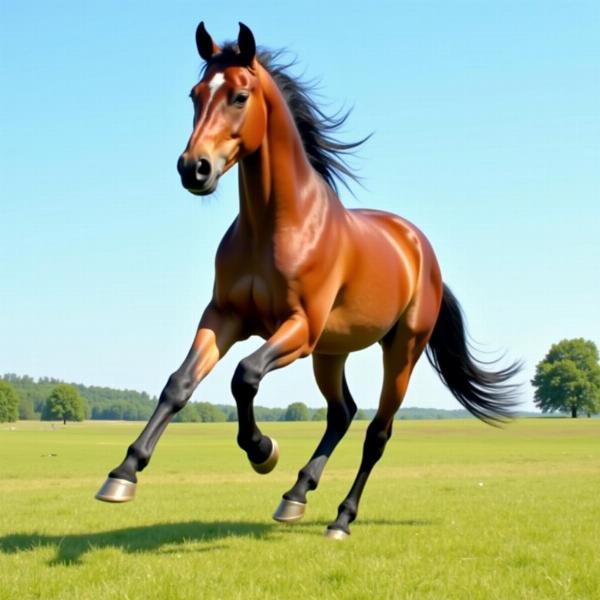Understanding the Hindi meaning of “gallop” opens up a fascinating window into how this dynamic action verb translates across languages and cultures. While a simple dictionary might offer a basic equivalent, grasping its nuances requires a deeper dive into the cultural context of Hindi and the rich imagery associated with horses in Indian tradition. This article explores the various ways “gallop” is expressed in Hindi, examining its literal translations, idiomatic uses, and cultural significance.
Decoding the Hindi Equivalent of Gallop
The most common Hindi translation of “gallop” is सरपट दौड़ना (sarpat daudna). This phrase literally translates to “run at full speed” and captures the essence of a horse’s rapid gait. While other terms like तेज़ दौड़ (tez daud) (fast run) or दौड़ लगाना (daud lagana) (to run) can be used, they lack the specific connotation of a horse’s galloping motion. Sarpat daudna specifically evokes the image of a horse stretching its legs and covering ground quickly, much like the English word “gallop.”
 A horse galloping at full speed – sarpat daudna
A horse galloping at full speed – sarpat daudna
Galloping Through Hindi Idioms
Beyond the literal translation, “gallop” also finds its way into Hindi idioms. For instance, the phrase “घोड़े बेकाबू सरपट दौड़ रहे हैं” (ghode bekabu sarpat daud rahe hain) which means “the horses are galloping uncontrollably” is often used metaphorically to describe a situation spiraling out of control. This usage highlights how the powerful imagery of a galloping horse can be employed to express abstract concepts.
Cultural Context: The Horse in India
The significance of the horse in Indian culture adds another layer to understanding the Hindi meaning of “gallop.” Horses have long been revered in India, appearing in mythology, religious texts, and historical narratives. From the majestic steeds of kings and warriors to the divine horses of Hindu deities, the animal holds a special place in the Indian psyche. This reverence adds a layer of cultural richness to the Hindi translations of “gallop,” connecting the word to a broader tapestry of tradition and symbolism.
Galloping into Different Contexts: From Literature to Everyday Life
The Hindi meaning of “gallop” can vary slightly depending on the context. In literature, especially poetry, more evocative and descriptive terms might be used to capture the beauty and power of a galloping horse. For instance, a poet might use the word धड़धड़ाना (dhadhadana) – which refers to the thundering sound of hooves – to paint a vivid picture of a horse galloping. In everyday conversation, however, the simpler and more direct sarpat daudna is generally preferred. Think of describing ghora meaning in hindi galloping across a field.
What is the difference between running and galloping in Hindi?
Running in Hindi can be translated as दौड़ना (daudna), a general term encompassing various speeds. Galloping, specifically सरपट दौड़ना (sarpat daudna), describes a horse’s fastest gait, a full-speed run with a distinct three-beat rhythm. Think about slow motion meaning in hindi compared to galloping – a stark contrast in speed and motion. It’s similar to the distinction between meaning of gallop in hindi and a simple jog.
Conclusion
Understanding the Hindi meaning of “gallop” involves more than just finding a direct translation. It requires delving into the cultural significance of the horse in India and appreciating the nuances of the language. From the literal translation of sarpat daudna to its idiomatic usage and literary interpretations, “gallop” in Hindi evokes a powerful image that resonates deeply within Indian culture. Learning meaning of galloping in hindi provides insight into both language and culture.
FAQ
- What is the most accurate Hindi translation of “gallop”? The most accurate and commonly used translation is सरपट दौड़ना (sarpat daudna).
- Are there other ways to express “gallop” in Hindi? While sarpat daudna is the most precise term, other phrases like तेज़ दौड़ (tez daud) can be used in a broader sense, although they lack the specific connotation of a galloping gait.
- How is “gallop” used metaphorically in Hindi? The imagery of galloping horses is often used to describe situations that are quickly escalating or spiraling out of control.
- Why is understanding the cultural context important when translating “gallop” into Hindi? The horse holds significant cultural and historical importance in India, adding a layer of richness to the understanding of the word “gallop” and its Hindi equivalents.
- Does the Hindi meaning of “gallop” change depending on the context? Yes, the specific word choice might vary slightly depending on whether it’s used in everyday conversation, literature, or other specific contexts.
Meaning-Hindi.in is your trusted partner for accurate and culturally sensitive Hindi translations. We offer a wide range of translation services, from business and legal documents to website localization and academic texts. Our expert linguists understand the nuances of both Hindi and English, ensuring that your message is conveyed effectively and respectfully. Contact us today for a free quote at [email protected] or call us at +91 11-4502-7584. Meaning-Hindi.in is committed to providing high-quality translations that bridge linguistic and cultural gaps. We handle various specializations, including technical, legal, and business translations, ensuring your content resonates with your target audience.